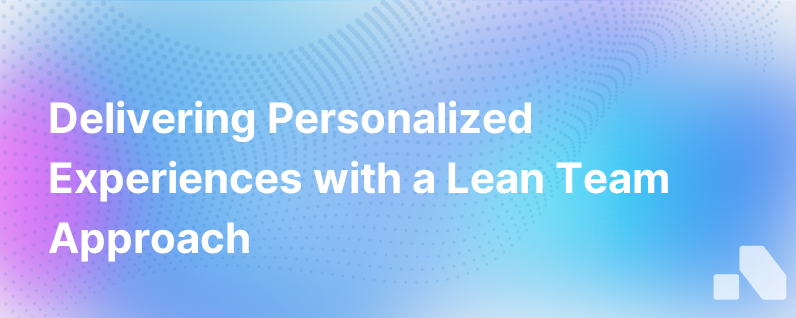
In the era of digital abundance, every customer craves to feel uniquely understood and catered to. Amid this rising demand for personalized experiences, many businesses may assume they need an infantry of marketers, a wealth of resources, and mountains of customer data to deliver effectively. Yet, this isn't necessarily the case. Personalization, at its core, is more an artful strategy than a resource-heavy endeavor. It’s about using the right tools and insights in a way that's scalable, even by a small team that punches above its weight. So, how does a lean team deliver a personalized experience that rivals that of a much larger army?
The Importance of Personalization for Businesses
Before we delve into the mechanisms of delivering personalized experiences sans an army, let's understand why personalization is slipping into every strategic business meeting's agenda. When consumers encounter personalized content, products, and offers, they are more likely to engage, convert, and stay loyal. A study by Epsilon found that 80% of consumers are more likely to make a purchase from a brand that provides personalized experiences.
Personalization goes beyond marketing—it influences customer's perceptions, fosters positive customer experience, and affects the long-term relationship between consumers and brands. Companies that excel at personalization can see a 10-15% increase in revenue, according to McKinsey & Company.
Building Personalized Experiences with Limited Resources
Leverage Technology
Technology is the great equalizer when it comes to personalization. Tools like Customer Relationship Management (CRM) software, data analytics platforms, and advanced marketing automation can help a small team deliver highly personalized experiences without significant human intervention. For instance, using AI to analyze customer data helps create tailored recommendations, while an automation platform can manage targeted email campaigns.
Understand Your Customer
A lean team should invest time in understanding the core customer base. This process involves curating customer personas, which are representative profiles of your target audience. They should reflect your customers' behavior patterns, goals, skills, attitudes, and environment, along with their buying journey.
Start with Segmentation
After establishing who your customers are, it’s crucial to segment them based on meaningful criteria such as demographics, psychographics, behavior, and lifecycle stages. This will enable you to send the right message to the right group, providing a sense of personal touch without needing to craft a unique message for every individual.
Use Data Smartly
Lean teams need to be judicious about which data they collect and act upon. Quality trumps quantity, and a small set of relevant data can be more valuable than a large amount of unstructured data. Moreover, being transparent about data collection and respecting privacy regulations builds trust with your customers.
Tailor the Content
Develop a content strategy that allows for variations to be built around a common framework. This could mean creating base templates for email campaigns that are then customized with personalized greetings, content, and offers based on the recipient's behavior and preferences.
Be Nimble and Adaptive
Small teams have the advantage of agility. You can quickly pivot strategies, try new tools, and adjust campaigns based on real-time feedback without the red tape that slows down larger organizations.
Quality Over Quantity
When it comes to delivering personalized experiences, focus more on the one-on-one interactions that create lasting impressions. Personalized follow-ups and support interactions can turn a routine transaction into a memorable customer experience.
Invest in Training
Ensure every team member is well-versed in the personalization tools and strategies you're using. A smaller team means each member's skills and expertise have an outsized impact on your personalization efforts.
Case Study: The Power of Personalization at Scale
A perfect illustration of a lean team utilizing smart personalization is Netflix. With a relatively modest team compared to its user base, Netflix uses an algorithm to provide movie and TV show recommendations tailored to the individual tastes of its millions of users. Their platform, powered by machine learning, takes viewing habits and compares them with similar user profiles to suggest content a particular viewer is likely to enjoy, creating a highly personalized experience.
Benefits of a Streamlined Approach to Personalization
Lean personalization has some clear advantages:
- It typically allows for a more authentic connection because a smaller team can align closer to the company's core values.
- It’s often easier to execute quickly, test, and iterate, allowing for a growth hacking approach to improving personalization strategies.
- It can be more cost-effective, ensuring that you're not using a sledgehammer to crack a nut when it comes to engaging your customers.
Each of these benefits illustrates how delivering a personalized customer experience doesn't require an army; rather, it necessitates a smart strategy, the right tools, and a deep understanding of your customers' needs and behaviors.
Conclusion
We've set forth an undeniable truth: Personalized experiences don't depend on hefty resources or vast numbers but rather the intelligent deployment of innovation, data, and customer-centric strategies. Using tailored approaches and lean methodologies, even the smallest teams can craft personalized experiences that resonate deeply with their customer base. It’s about the effective use of technology and human touchpoints where they matter most, and the results often speak for themselves—creating loyal customers, driving conversions, and building a brand known for truly understanding its audience.